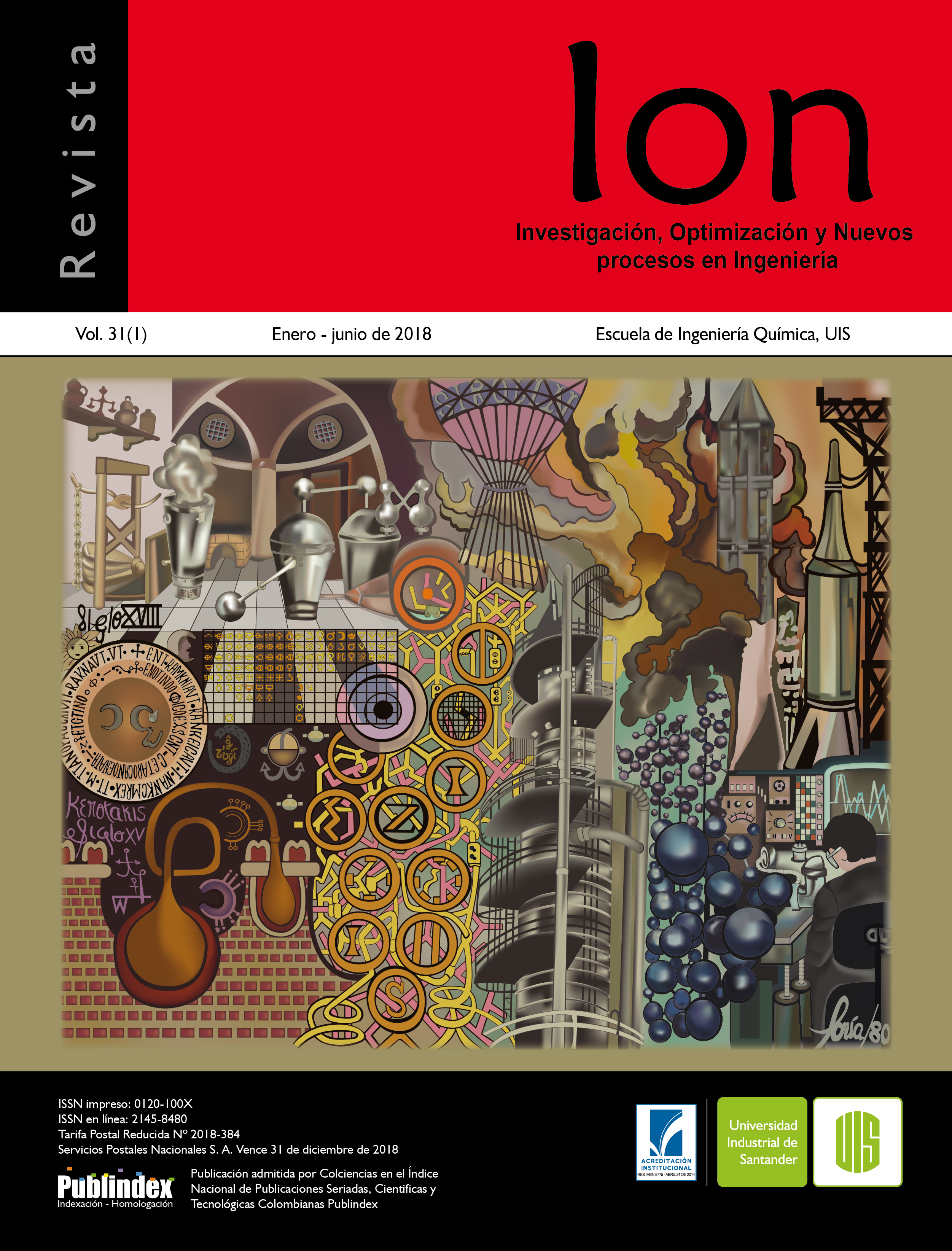Estimation of the content of total phenols in calendula essential oil (Calendula Officinalis L) obtained by OAHD
Published 2018-09-28
Keywords
- quantification of phenols and flavonoids,
- content of total phenols,
- calendula essential oil,,
- hydrodistillation of essential oils,
- ohmic heating
How to Cite
Abstract
This work forms part of the preliminary characterization of calendula (Calendula officinalis L.) essential oil obtained by two methods: hydrodistillation (HD) and ohmic-assisted hydrodistillation (OAHD); fresh flowers (Ff) and dried flowers (Fs) were used. Total phenols content was estimated with Folin-Ciocalteu reagent using tannic acid as standard (μg /mL). The effect of the methods and treatments on the total phenols content (μg/mL) was evaluated; results obtained showed significant differences (p <0.05) when comparing the interaction between flower states for the same extraction method, but this was not the case when flower states were compared irrespective of the extraction method (p≥ 0.05); therefore, the extraction methods used did not show effects on the content of phenols in each of the oil samples while the drying process does have an impact on the development of phenolic structures in the oil samples. It is necessary to continue working on the characterization of calendula flower essential oil obtained by HD and OAHD with regard to the chemical composition of each of the fractions as well as the measurement of the antioxidant activity using higher sensitivity analytical techniques.
Downloads
References
[2] Guoyuan Q, Yashi M, Rong F, Beita Z, Bo R, Xuebo L. Tea polyphenols ameliorates neural redox imbalance and mitocondrial dysfunction via mechanisms linking the key circadian regular Bmal1. Food Chem Toxicol. 2017;(18):125-218.
[3] Bento C, Gonçalves AC, Silva B, Silva LR. Assessing the phenolic profile, antioxidant, antidiabetic and protective effects against oxidative damage in human erythrocytes of peaches from Fundão. J Funct Foods. 2018;43:224-33.
[4] Paolini J, Barboni T, Desjobert JM, Djabou N, Muselli A, Costa J. Chemical composition, intraspecies variation and seasonal variation in essential oils of Calendula arvensis L. Francia. Biochem. Syst. Ecol. 2010;38(5):865-74.
[5] Loescher C, Morton D, Razic S, Kustrin S. High performance thin layer chromatography (HPTLC) and high performance liquid chromatography (HPLC) for the qualitative and quantitative analysis of Calendula officinalis—Advantages and limitations. J Pharm Biomed Anal. 2014;98:52-9.
[6] Damyeh M , Niakousari M. Impact of ohmic-assisted hydrodistillation on kinetics data, physicochemical and biological properties of Prangos ferulacea Lindle. Essential oil: Comparison with conventional hydrodistillation. Innov Food Sci Emerg Technol. 2016;33:387–96.
[7] Gavahian M, Farahnaky A, Farhoosh R, Javidnia K, Shahidi F. Extraction of essential oils from Mentha piperita using advanced techniques: Microwave versus ohmic assisted hydrodistillation. Food Bioprod. Process. 2015;94:50-8.
[8] Qarah NAS, Basavaiah K, Abdulrahman SAM. Spectrophotometric determination of ethionamide in pharmaceuticals using Folin–Ciocalteu reagent and iron(III)-ferricyanide as chromogenic agents. J Taibah Univ Sci. 2017;11(5):718–28.
[9] Paladino S. Actividad antioxidante de los compuestos fenólicos contenidos en las semillas de la vid (Vitis vinifera l.). Mendoza, Argentina: Universidad Nacional de Cuyo.2008.
[10] Determinación colorimétrica de fenoles solubles en material vegetal mediante el reactivo de Folin-Ciocalteu (sitio en internet).Disponible en: http://www.mncn.csic.es/docs/repositorio/es_ES/investigacion/cromatografia/fenoles_en_planta.pdf. Acceso el 12 de octubre de 2017.
[11] Ainsworth EA, Gillespie KM. Estimation of total phenolic content and other oxidation substrates in plant tissues using Folin–Ciocalteu reagent. Nat Protoc. 2007;2(4):875-7.
[12] Memarzadeh SM, Pirbalouti AG, Adibnejad M. Chemical composition and yield of Essential oils from Bakhtiari savory (Satureja bachtiarica Bunge.) under different extraction methods. Ind Crops Prod. 2015;76:809-16.
[13] Delgado J, Sánchez MS, Bonilla CR. Efecto del secado y la edad de las plantas en la composición de los aceites esenciales de Lippia alba (Mill.) N.E.Br. ex Britton & P. Wilson y Lippia origanoides Kunth. Acta Agron.2016;65(2):170-5.
[14] Kumar R, Sharma S, Sharma S, Kumar N. Drying methods and distillation time affects essential oil content and chemical compositions of Acorus calamus L. in the western Himalayas. J Appl Res Med Aromat Plants. 2016;3(3):136–41.
[15] Pirbalouti AG, Salehi S, Craker L. Effect of drying methods on qualitative and quantitative properties of essential oil from the aerial parts of coriander. J Appl Res Med Aromat Plants. 2017;4:35-40.
[16] Johnson CE, Oladeinde FO, Kinyua AM, Michelin R, Makinde JM, Jaiyesimi AA, et al. Comparative assessment of total phenolic content in selected medicinal plants. Niger J Nat Prod Med. 2008;12:40.
[17] Sytar O, Hemmerich I, Zivcak M, Rauh C, Brestic M. Comparative analysis of bioactive phenolic compounds composition from 26 medicinal plants. Saudi J Biol Sci. 2016.
[18] Domínguez Marín L. Utilización de flores de caléndula (Calendulae flos) en salsa para carnes (Tesis Especialización). Bogotá, Colombia: Universidad Nacional; 2009.
[19] Abudunia AM, Marmouzi I, Faouzi MEA, Ramli Y, Taoufik J, El Madani N, et al. Anticandidal, antibacterial, cytotoxic and antioxidant activities of Calendula arvensis flowers. J Mycol Med. 2017;27(1):90-7.

